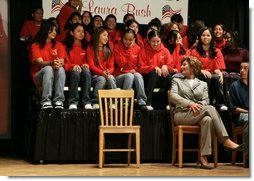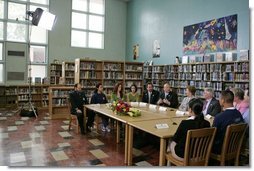|
Home >
News & Policies >
April 2005
|
For Immediate Release
Office of the First Lady
April 27, 2005
Mrs. Bush's Remarks on Helping America's Youth in Sun Valley, California
Sun Valley Middle School
Sun Valley, California
10:54 A.M. PDT
MRS. BUSH: Thank you very much, Victor. Victor, you did a wonderful job. Congratulations on making great improvements in your reading ability. Victor's achievement shows what happens when you provide students with really good teachers and language arts programs that are proven to work. Congratulations, Victor. (Applause.)
 And Mr. Davis, thank you very much. Thank you for your leadership
here at Sun Valley Middle School, and thank you for your example that
you set for principals around the country. And I especially want to
acknowledge former governor Roy Romer, Superintendent of Los Angeles
Unified School District. Thank you, Governor Romer, for joining us
here today. (Applause.)
And Mr. Davis, thank you very much. Thank you for your leadership
here at Sun Valley Middle School, and thank you for your example that
you set for principals around the country. And I especially want to
acknowledge former governor Roy Romer, Superintendent of Los Angeles
Unified School District. Thank you, Governor Romer, for joining us
here today. (Applause.)
And a very, very special thanks to all the teachers who are here. We're grateful to you for helping our sons and daughters succeed. Thank you, teachers. (Applause.)
Teaching and education are critical components of a new initiative called Helping America's Youth. The goal of Helping America's Youth is to help children make good decisions in their lives so that they can grow up to be healthy and successful adults. The initiative calls for action in the three most important parts of a child's life: a child's family, a child's school, and a child's community. We're emphasizing the needs of boys because statistics show us that boys are more likely to fall behind girls in school, more likely to drop out of school, and today in America, fewer boys than girls go on to college or to graduate school.
We know that boys and girls, especially as they get to their teen years, face hazards. Smoking and drinking may look appealing to children when they see older kids doing it. Drugs are a temptation. Young people often feel pressured to have sex. Gangs and violence are a regular presence in many neighborhoods. These challenges aren't limited to any one part of the country or to any one segment of the society. Every child has to make choices between healthy behaviors that lead to success, and risky behaviors that can lead down a road to bad outcomes. Our responsibility as adults is to help children resist negative pressures, and then to help them excel in every part of their lives.
Schools are central to a child's life. For at least six hours a day, boys and girls come here to learn the knowledge and the skills they'll need to become intelligent and discerning adults. We also want them to learn to respect themselves and others. We want them to learn that they're responsible for the choices they make in life. Students who do well academically and emotionally are more likely to stay interested in their schoolwork, to avoid negative behaviors, and to graduate from high school and go on to college.
Researchers in Baltimore found out that children have to learn how to be good students; it's not just intuitive. So they devised a program called the Good Behavior Game that helps first graders learn how to behavior in the classroom. Studies show that first graders in Baltimore public schools who participated in the Good Behavior Game are better behaved and less disruptive in class all the way through high school. In fact, 86 percent of the children who participated in the Good Behavior Game graduated from high school, compared with just 19 percent of their peers.
 In Atlanta, middle school students are learning how to debate. The
Computer Assisted Debate project -- or Cad -- is helping students from
the city's housing projects improve their vocabulary and their language
skills, which makes it more likely that they'll complete high school
and go on to college. CAD also helps students find their voice.
Rather than turning to violence and anger as a means of expression,
debate is a healthier option, safer for children and for their
community.
In Atlanta, middle school students are learning how to debate. The
Computer Assisted Debate project -- or Cad -- is helping students from
the city's housing projects improve their vocabulary and their language
skills, which makes it more likely that they'll complete high school
and go on to college. CAD also helps students find their voice.
Rather than turning to violence and anger as a means of expression,
debate is a healthier option, safer for children and for their
community.
Here at Sun Valley, you're helping students avoid the hazards of gangs and violence by developing a strong character, and you're helping students prepare for a lifetime of success by improving their reading and language skills. This school has been through difficult times, but over the last few years, you've made impressive gains. We see it in your test scores, but we also see it -- and this is most important -- in your students, like Victor, who have a better chance of success because of the caring teachers here at Sun Valley.
Every student's success depends on reading. Students who can make it to high school without sound reading skills are at a greater risk of bad behavior, depression, substance abuse and violence. They are also much more likely to drop out of school. Teenagers who have reading problems have told researchers at the National Institutes of Health that they hate to read, primarily because it's such hard work, and their reading is slow and laborious. One teenager said, "I would rather have a root canal than read." (Laughter.)
Education research now gives us a better understanding of how people at different stages of life respond to different methods of teaching. What works for a student in the third grade won't necessarily work for a student in the sixth grade or the eighth grade. And when students are learning English as a second language, like nearly half the students here at Sun Valley, they have even greater challenges. At this school, teachers have the skills and the reading programs to help all children improve their reading ability, and to motivate students to communicate well in English.
Salvador Nolasco-Sanchez is in the eighth grade at Sun Valley. He was an honors student in elementary school, but as he grew older, he began to get off track. He and his friends were involved in gang-related violence. Sal's grades dropped, his attitude became negative, and he started to lose interest in school. By the time he reached middle school, Sal had experienced having a gun pointed at his head by a rival gang member. Disciplinary problems forced him to transfer schools. He was placed in lower-level classes, wh! ich frustrated him. In order to come back to Sun Valley, Sal made a promise to Principal Davis that he would focus on his schoolwork and stay away from violence. He was involved in a program called "Language!" and quickly he improved his reading schools.
Today, Sal is passing all of his classes. He has a particular talent for math, and he's pretty impressive on the football field, too. Sal's future is bright, because his family and his teachers showed him that he could be a successful student. Sal, would you stand up and be recognized? (Applause.)
Congratulations, Sal. And I know that Sal and Victor's stories aren't the only stories in this room. There are a lot of other kids here who have focused and worked hard so they also can bring their reading level up, and I hope that all of you also have the goal of going to college.
The Striving Readers program, which is part of Helping America's Youth, helps school districts implement research-based reading programs like "Language!" that's helping Salvador. As more schools use programs that are proven to work, more students will have the chance to improve their reading skills. They'll be more likely to stay in school and gain the education they need to be successful adults.
Last year, Striving Readers was introduced with $25 million in funding. For 2006, President Bush has requested $200 million for school districts to access so that more middle- and high school-age students can improve their reading skills. The President has also requested more than $24 million for a Character Education Initiative to encourage schools to teach strong values, to promote good character, and to help children develop a sense of responsibility to their own families and to their community. And he's proposed -- (applause) -- and he's proposed a new three-year $150 million initiative to help children avoid gang involvement and gang violence.
One of the most important ways the federal government can help local communities is by fostering connections between people who are running good programs, like the people here at Sun Valley, and people who want to get started. This fall, we'll convene a White House Conference on Helping America's Youth to discuss some of the best practices to help children avoid risky behaviors and become responsible, healthy adults. The conference will introduce a new assessment tool to help communities identify the challenges that they face, and the services that already exist that they have to meet them. Then community leaders can integrate federal and local prog! rams to create seamless efforts to help children.
Helping America's Youth depends on partnerships between all members of a community and it depends on the individual commitment of all Americans. The time between childhood and adulthood is all too short, as George and I can attest, and every moment in a child's life is precious. After I visited a program in Detroit, a newspaper reporter asked one of the little boys that I met what he thought of my visit, and I was moved when I read that he simply said, "I wish she could stay here."
Children want us in their lives, and children need us in their lives. And as I've learned from the remarkable men and women that I've met here today, each of us has the power to make the difference in the life of a child. Thank you all very much. I especially want to thank the students who are here today. Thank you all. (Applause.)
END 11:02 A.M. PDT
![]() Printer-Friendly Version
Printer-Friendly Version
![]() Email This Page
Email This Page


